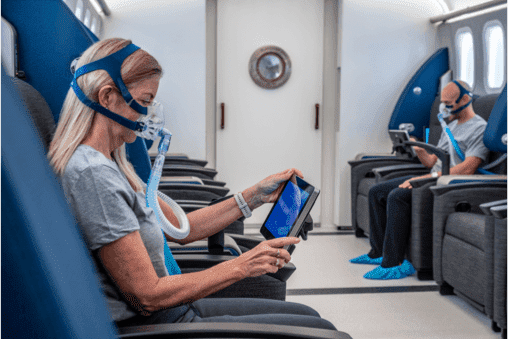Key Takeaways:
- Hyperbaric Oxygen Therapy (HBOT) delivers high concentrations of oxygen under increased atmospheric pressure for therapeutic benefits.
- HBOT promotes wound healing, reduces inflammation, enhances the immune response, and fights infection.
- Conditions that can benefit from HBOT include chronic wounds, stroke recovery, and managing pain and inflammation.
- HBOT also shows potential as a complementary therapy for autism spectrum disorders, in sports medicine, and for neurological disorders.
- During HBOT sessions, it’s important to know what to expect and the potential side effects.
- Maximizing healing with HBOT can involve maintaining a healthy lifestyle and exploring complementary therapies.
Hyperbaric Oxygen Therapy (HBOT) is a revolutionary medical treatment that has been garnering attention for its potential healing powers. By delivering high concentrations of oxygen under increased atmospheric pressure, HBOT can provide a range of therapeutic benefits for various medical conditions.
In this comprehensive guide, we will delve deep into the science behind HBOT, explore the conditions that can benefit from this therapy, discuss alternative therapeutic uses, and provide insights into the HBOT experience.
The Science Behind HBOT
1. Understanding Hyperbaric Oxygen Therapy
Hyperbaric Oxygen Therapy, also known as HBOT, is a medical treatment that involves breathing 100% pure oxygen in a pressurized environment. The treatment takes place inside a hyperbaric chamber, which can be a rigid, inflatable, or even a multi-place chamber that can accommodate multiple patients. HBOT can be administered as a standalone treatment or as part of a comprehensive plan in conjunction with other medical interventions.
2. How Does HBOT Work?
HBOT relies on the principle that the increased atmospheric pressure and higher oxygen levels in the body can have profound effects on various physiological processes. When a person undergoes HBOT, the increased pressure allows the body to take in a greater amount of oxygen, thus saturating the blood plasma and other bodily fluids. This oxygen-rich environment promotes healing and helps combat a wide range of medical conditions.
3. The Physical and Biological Effects of HBOT
HBOT has numerous physical and biological effects on the body, all of which contribute to its therapeutic benefits. The increased oxygen levels significantly enhance the body’s ability to heal wounds by stimulating the growth of new blood vessels and promoting tissue regeneration. HBOT can also reduce inflammation and swelling, enhance the body’s immune response, and improve the body’s ability to fight infection.
Conditions that Can Benefit from HBOT
1. Healing Wounds and Injuries
Hyperbaric Oxygen Therapy (HBOT) stands out prominently among the applications of oxygen-based therapies, particularly in healing chronic wounds and injuries. By elevating oxygen levels in the bloodstream, HBOT facilitates a quicker recovery of injured tissues. It encourages the growth of new blood vessels, boosts collagen synthesis, and activates the release of growth factors critical for repairing wounds. Beyond chronic conditions, HBOT has demonstrated efficacy in managing acute injuries, including sports-related traumas and bone fractures, showcasing the breadth of understanding oxygen-based therapies.
2. Enhancing Stroke Recovery
Stroke is a leading cause of long-term disability, and its effects can be devastating. However, HBOT has emerged as a potential treatment option to enhance stroke recovery. The increased oxygen levels provided by HBOT can help reduce brain swelling, promote the growth of new blood vessels, and stimulate neuroplasticity, which is the brain’s ability to reorganize and form new connections. These mechanisms can improve neurological function and enhance the recovery process for stroke survivors.
3. Managing Pain and Inflammation
Chronic pain and inflammation can significantly impact a person’s quality of life. HBOT has been found to have analgesic properties, effectively reducing pain in various medical conditions, including complex regional pain syndrome (CRPS), fibromyalgia, and neuropathic pain. The therapy can also help reduce inflammation by modulating the activity of inflammatory cells and promoting tissue repair. By addressing both pain and inflammation, HBOT can provide relief and improve overall well-being.
Exploring Alternative Therapeutic Uses
1. HBOT for Autism Spectrum Disorders
Autism Spectrum Disorders (ASD) are characterized by a range of developmental challenges, including social interaction difficulties and repetitive behaviors. While there is no cure for ASD, HBOT has shown promise as a complementary therapy to improve certain symptoms associated with the condition. The increased oxygen levels provided by HBOT can enhance brain function, reduce inflammation, and promote neuroplasticity, all of which can contribute to improved cognitive function and behavior in individuals with ASD.
2. HBOT in Sports Medicine
Professional athletes and sports enthusiasts are no strangers to injuries and the need for quick recovery. HBOT has gained popularity in the field of sports medicine due to its ability to enhance healing and reduce downtime. By increasing oxygen delivery to the injured tissues, HBOT can speed up the recovery process for sports-related injuries, such as sprains, strains, and fractures. Additionally, the therapy can also help athletes improve their endurance and performance by increasing oxygen availability during strenuous physical activity.
3. HBOT and Neurological Disorders
Neurological disorders, including multiple sclerosis, cerebral palsy, and traumatic brain injury, can have a profound impact on a person’s life. HBOT has shown promise in the treatment of these conditions by addressing the underlying neurological damage. The therapy can improve brain function, reduce inflammation, and promote the regeneration of damaged nerve tissues. These effects can lead to improvements in motor function, cognition, and overall quality of life for individuals with neurological disorders.
Understanding the HBOT Experience
1. What to Expect during HBOT Sessions
When undergoing HBOT, it is essential to know what to expect during the sessions. Typically, a session can last from 60 to 120 minutes, during which you will be comfortably positioned inside the hyperbaric chamber. The chamber will be pressurized, and you may experience a sensation similar to that of an airplane taking off or landing. It is important to remain relaxed and follow the instructions of the healthcare professionals overseeing the treatment.
2. Safety and Potential Side Effects
HBOT is generally considered safe when administered by trained professionals. However, like any medical treatment, there are potential side effects to be aware of. These can include ear barotrauma, sinus discomfort, temporary vision changes, and oxygen toxicity in rare cases. It is crucial to discuss any pre-existing medical conditions or concerns with your healthcare provider to ensure the therapy is suitable and safe for you.
3. Tips and Strategies for Maximizing Healing
To maximize the healing potential of HBOT, there are several tips and strategies to keep in mind. Maintaining a healthy lifestyle, including a balanced diet and regular exercise, can support the body’s healing processes. Staying hydrated and getting adequate rest can also aid in recovery. Additionally, it can be beneficial to explore complementary therapies, such as physical therapy or acupuncture, to enhance the effects of HBOT. It is important to work closely with your healthcare team to develop a comprehensive treatment plan tailored to your specific needs.
Hyperbaric Oxygen Therapy (HBOT) holds tremendous promise as an innovative and effective medical treatment. From healing wounds and injuries to improving stroke recovery and managing pain and inflammation, HBOT has shown remarkable therapeutic advantages. Furthermore, the therapy’s potential extends beyond conventional uses, with emerging applications in the treatment of autism spectrum disorders, sports medicine, and various neurological conditions.
Understanding the science behind HBOT, along with its benefits and potential side effects, can empower individuals to make informed decisions about their healthcare. By diving deep into the subject and exploring the extensive research and real-life experiences, this guide aims to provide valuable insights and comprehensive knowledge about the healing powers of HBOT.







